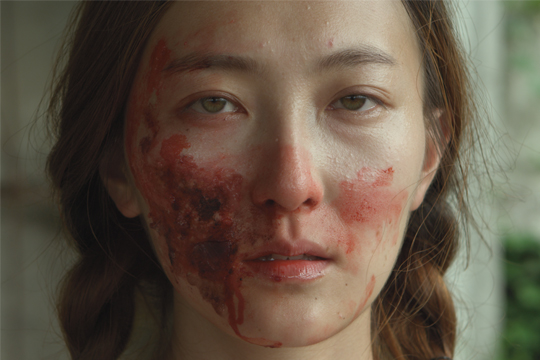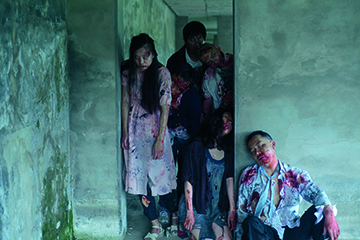COMING TO BEIJING: DEAD ON ARRIVAL
| January 8, 2014 | Post In LEAP 24

Courtesy of the artist and Vitamin Creative Space
Haze and Fog is produced by Eastside Projects and Vitamin Creative Space. It is commissioned by University of Salford and Chinese Art
Centre, Eastside Projects, and Bath School of Art and Design, Bath Spa University, with Vitamin Creative Space.
I’m A. Zombie and I just keep coming back. No one is sure where I originate from but everyone knows I’m going to be around forever. I have my own theories; some proof even. I’ve commissioned research, the way humans do when they want to know about their ancestors. Zombies may be living dead, but, we have feelings too. Just not the kinds of feelings you happen to value.
I’ve recently starred in a film by the artist Cao Fei. The English title is Haze and Fog. In the story, we, the zombies, are slowly taking over one of the new housing complexes outside of Beijing. It’s named after a fairy tale. You know the kind. Big residential blocks. Neat open space. Security guards who let people in and out. Cool little cafes.
I’ve been told these complexes are symptoms or signs that China is moving in a certain direction. I’m still not sure exactly what that is. But I’m happy that I’ve been invited here. It’s my first time. Because we, the zombies, haven’t had much work in China. Especially in the Chinese film industry. I can’t name a famous Chinese zombie movie. Can you?
But Cao Fei thinks this is going to change. So she’s made a film about this change.
In Haze and Fog, you see us, the zombies, living side by side with the humans. In fact, sometimes, during shooting, I wasn’t sure who was a zombie and who wasn’t. I’d like to think the human actors felt exactly the same. You should ask them the next time. That is, if there are any left.
Just kidding! Zombie humor.
Is this what life here, in Beijing, feels like? Tastes like? It’s eerie. Cao Fei seems to suggest that the effects of watching a large flat-screen TV too much might be worse than being a zombie. Maybe I’m biased. Maybe I’m incapable of empathy. Why do humans value empathy so much? Please explain. I’m listening.
And then, one of the human actors told me that his family also lived in this sort of place. They moved in a year ago. He said that his grandparents could not get used to so much space. So much whiteness. They would hear things in the corridors. “Spirits.” In Cao Fei’s film, you see a watermelon splatter in a corridor. It’s how we used to do blood effects back in the 1960s. I miss the Cold War, so much.
I’m no expert on China and I’m certainly no economist. I’m just a regular time traveling zombie who’s worked with some of the finest film directors (does that make me sound arrogant?). But, I have to tell you that the combination of Beijing’s gray, opaque sky—the haze and fog that feels generated on a computer screen—and these virginal buildings whose size are way out of scale with what humans here are used to… All of this makes us feel at home. It’s a suitable climate. Cao Fei told me she’d never make a zombie movie in her hometown Guangzhou. “Beijing needed you,” she said. Cao Fei never lies.
Before I got here, I was working on an American TV show called The Walking Dead. Have you seen it? A huge hit. Truth be told, for a while, we, the zombies, were worried. Everything had gone “vampire.” Twilight was an inspiration for Haze and Fog, Cao Fei said. But Max Brooks’ book World War Z, which came out in 2006, changed things once again. Brooks said that, “Other monsters may threaten individual humans, but the living dead threaten the entire human race… Zombies are slate wipers.”

Courtesy of the artist and Vitamin Creative Space
Haze and Fog is produced by Eastside Projects and Vitamin Creative Space. It is commissioned by University of Salford and Chinese Art
Centre, Eastside Projects, and Bath School of Art and Design, Bath Spa University, with Vitamin Creative Space
The film adaptation was a nightmare to work on: you may have read about the successive disasters. Very nearly didn’t get finished. In the end, it lost a lot of what made the book unique. (“Oral histories” with zombies. Great idea!) But what the film does do is make our threat to humans truly twenty-first century in reach. We’re no longer a single outbreak in a single town or city. We’re globalized now. We’ve got pandemic potential. We will follow capital to wherever it’s flourishing the most. In that way, we’re a lot like contemporary art. We like contemporary art.
Some humans tell me consumerism makes people “zombified.” Have to admit: I get offended by this. I mean. We’re so much more than just desensitized, over materialized nonentities beaten into emotional submission by a lust for microwave ovens and smartphones. We actually live simple lives. We’ve chosen malls so often because there’s lot to do in one place. Plus, they stay open late.
What I liked about Cao Fei’s film was we weren’t fetishized the way recent American zombie films have fetishized us. I mean: look back to Night of the Living Dead. Yes, it was 1968. Yes, special effects weren’t as sophisticated. But look at how we moved. Slowly. We inched across the ground, and yet we still managed to cause chaos with the authorities. I maintain: a slow zombie is a scarier zombie. The fast ones are like fast food. I’m definitely supporting a Slow Zombie campaign here in China. Call me traditional but that’s the way forward. For everything.
The cameraman’s wife was an economist. She had researched vampires vs. zombies. During times of human economic boom, she says, more vampire films are made. Vampires are considered sexy, well dressed, with an eye for the beautiful things in life and death. They’re played by Tom Cruise or Robert Patterson. Heartthrobs. When the economy takes a turn for the worst: boom! The zombie film is hot again! What I want to know is: when has a zombie ever been played by someone handsome or beautiful or famous? We’re just some faceless mass, maliciously infecting the healthy. We’re bad debt, toxic mortgages, we’re credit card suicide, the 1% except we look like the lowest rung of the 99%. Blah blah. Yawn.
I’ve gotten used to all this. Being typecast is how I make a living. Thing is, as I said at the start, we have the last laugh—because we’re not going anywhere. We’re dead already. Try and kill us and we’ll just laugh some more. Ha. Ha. Ha. See you at the nearest capitalist apocalypse—and don’t forget to bring your credit card!


